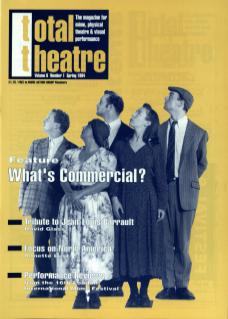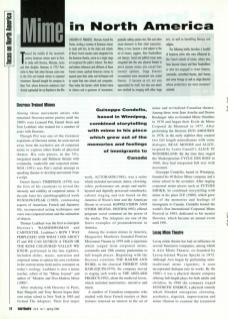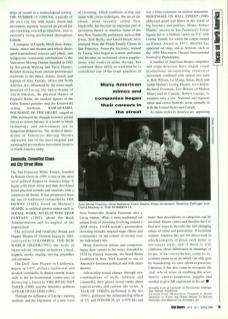Decroux-Trained Mimes
Among those movement artists who remained Decroux mime purists until the 1980s were Leonard Pitt, Daniel Stein and Tom Leabhart who trained for a number of years with Decroux.
Though Pitt was one of the foremost exponents of Decroux mime, he soon moved away from the exclusive use of corporeal mime to explore other kinds of physical theatre. His solo pieces, in the 70s, integrated masks and Balinese theatre with commedia, vaudeville and corporeal mime. Ned (1991) was Pitt's initial attempt in speaking theatre to develop movement from a script.
Daniel Stein's Timepiece (1978) was the first of his creations to reveal the intensity and nobility of corporeal mime. A decade later his autobiographical work Windowspeak (1989), contrasting aspects of American, French and Japanese life, incorporated acting techniques and voice into corporeal mime and the animation of objects.
Thomas Leabhart was the first to interpret Decroux's Washerwoman and Carpenter. Leabhart's How I Was Perplexed and What I Did About It and We Can Outrun a Train or the Rose Coloured Valley We Knew, performed in the late eighties, included slides, music, narration and corporeal mime to satirise his own evolution in the current mime field and to comment on today's ecology. Leabhart is also a mime teacher, editor of the Mime Journal and author of Modern and Post-Modern Mime (1989).
After studying with Decroux in Paris, Kari Margolis and Tony Brown began their own mime school in New York in 1983 and formed The Adaptors. Their first major work, Autobahn (1984), was a satire which included movement, dance, clowning, video, performance art, props and multi-layered and digitally processed soundtracks, cabaret singing and text based on the America of Nixon's time and the American Dream in reversal. Koppelvision and Other Digital Deities (1992) offered poignant social comment on the power of the media. The Adaptors are one of the finest examples of postmodernism in America.
Among the women mimes in America, Marguerite Matthews founded Pontine Movement Theatre in 1979 with a repertoire which ranged from corporeal mime, commedia and 19th Century pantomime to full-length pieces. Beginning with the Decroux creations The Baker and Work, to the classical Pierrot and Harlequin (1979), the company moved to staging such works as The Abelard Project (1992), about the medieval lovers, which included marionettes, narrative and music.
A number of Canadian companies who studied with these French masters or their trainees renewed an interest in the art of mime and revitalised Canadian theatre. Among these were Jean Asselin and Denise Boulanger who co-founded Mime Omnibus in 1970 and began their Ecole de Mime Corporel de Montreal in 1977. After performing the Decroux Duo Amoureux in 1978, in the early eighties they created two full-length mimodramas with some dialogue, Beau Monde and Alice, inspired by Lewis Carroll's Alice in Wonderland. By the time they staged the Shakespearian Cycle des Rois in 1988, they had integrated full text with movement.
Giuseppe Condello, based in Winnipeg, founded his 40 Below Mime company and a mime school in the seventies. After staging corporeal mime pieces such as Future Shokk, he combined storytelling with mime in his piece D.P. (1989), which grew out of the memories and feelings of immigrants to Canada. Condello hosted the world's first International Corporeal Mime Festival in 1983, dedicated to his mentor Decroux, which became an annual event until 1991.
Lecoq Mime Theatre
Lecoq mime theatre has had an influence on several Vancouver companies, among which is Axis Mime Theatre, co-founded by Lecoq-trained Wayne Specht in 1975. Although Axis began by performing semi-traditional mime vignettes, it soon incorporated dialogue into its works. By the 1980s it was a physical theatre company offering full-length plays for both adults and children. In 1986 the company staged Synthetic Energy, a physical comedy which blended outrageous clowning, acrobatics, slapstick, improvisation and mime illusion to examine the tyrannical reign of sound in a technological society. The Number 14 (1993-94), a parody of life on a city bus with masks, mime and movement, recently received an award for outstanding overall production, and is currently being performed throughout Canada.
A company in Canada which fuses dance, music, mime and theatre and which draws upon transcultural sources and ethnic and indigenous community celebrations is the Vancouver Moving Theatre founded in 1983 by Savannah Walling and Terry Hunter. Besides drawing from ancient performance traditions in the dance, drama, rituals and legends of Asia, Europe, Africa and North America, it is influenced by the mime-mask theories of Lecoq, the dance-drama of Alwin Nikolais, the physical theatre of Eugenio Barba, the masked figures of the Odin Teatret parades and the Grotowski acting methods. Samarambi, Pounding of the Heart, staged in 1986, portrayed the struggle between primal forces to restore balance in a world in which technology and environment are in dangerous disharmony. The mythical dance-drama of Vancouver Moving Theatre represents one of the most original and meaningful postmodern movement theatres in North America today.
Commedia, Committed Clown and City Street Mime
The San Francisco Mime Troupe, founded by Ronnie Davis in 1959, is one of the most vocal political theatres in America today. It began with silent mime and then developed broad physical comedy and musicals with a controversial theme. It has progressed from the use of traditional commedia in The Dowry (1962), based on Molière's Scapin, to political protest satires such as Social Work, An Election Year Fantasy about the Bush Administration and its neglect of the impoverished.
The political and ritualistic Bread and Puppet Theatre of Vermont, begun in 1961, conveyed in Columbus, The New World Order (1991) the evils of imperialism through primitive ritual, puppets, masks, singing, moving ensembles and narration.
The Dell'Arte Players in California, begun in 1977, utilises traditional and modern commedia to depict current issues such as the environmental controversy of destroying a forest in The Road Not Taken (1986) and the homeless problem in Fear of Falling (1991).
Through the influence of Lecoq's training methods and the expansion of a new wave of clowning, which combines acting and mime with circus techniques, the art of the clown, more recently called New Vaudeville, has become an important part of movement theatre in America. Some of the best New Vaudeville performers such as Bill Irwin, Bob Berky and Geoff Hoyle have emerged from the Pickle Family Circus in San Francisco. Avner the Eccentric, trained by Lecoq, who began as a street performer and became an acclaimed clown-juggler-mime who works in mime therapy, has combined these skills so well that he is considered one of the avant-guardists of New Vaudeville. Ronlin Foreman, also a Lecoq trainee, offers a more traditional yet unique form of clowning revolving around a child clown. Fred Curchak's postmodern clowning includes magical stage effects and commentary on the control of society over the individual's life.
Many American mimes and companies began their careers in the street. Founded in 1975 by Patrick Sciaratta, the Bond Street Coalition in New York started as one of America's foremost political and folk street theatres. Advocating social change through new combinations of myth, folklore and commedia, their pieces reveal truths about topical events and current life styles. A Tale of Vision, performed in the late 1970s, portrayed the dehumanising effects of TV, and Power Play (1979-84) was a bitter comment on nuclear armament. Nightmare on Wall Street (1990) addressed greed and ethics in the world of big business and politics. Mime artist Robert Shields’ success in San Francisco's Union Square led to a brilliant career on TV with Lorene Yarnell, for which the couple earned an Emmy Award in 1977. Shields has appeared on stage and at festivals such as the 1989 Movement Theatre International Festival in Philadelphia.
A number of American theatre companies and stage directors have staged visual productions incorporating expressive movement combined with spoken text such as Bob Wilson, La Mama, Julian Beck and Judith Malina's Living Theatre, Joe Chaikin, Richard Foreman, Lee Breuer of Mabou Mines, and, in Canada, Robert Lepage to mention only a few. National and regional mime and clown festivals occur annually in both the United States and Canada.
As mime styles in America are appearing faster than descriptions or categories can be invented, theatre critics and theorists have to find new ways to describe the fast-changing nature of mime and pantomime. If 20th Century America has not yet discovered in which category to place each mime or movement style, and if there is still confusion about differences in meanings of terms, it has nevertheless come to re-evaluate mime as an art which can only gain by broadening its own silent expression. Likewise, it has also come to recognise the vital role of mime in enabling the actor, dancer, clown, puppeteer, juggler and acrobat to give full expression to his art.
Annette Lust is Lecturer at Dominican College San Rafael, California. Excerpt from 'Movement Theatre in North America' in From the Greek Mimes To Marcel Marceau and Beyond, by Annette Lust.


